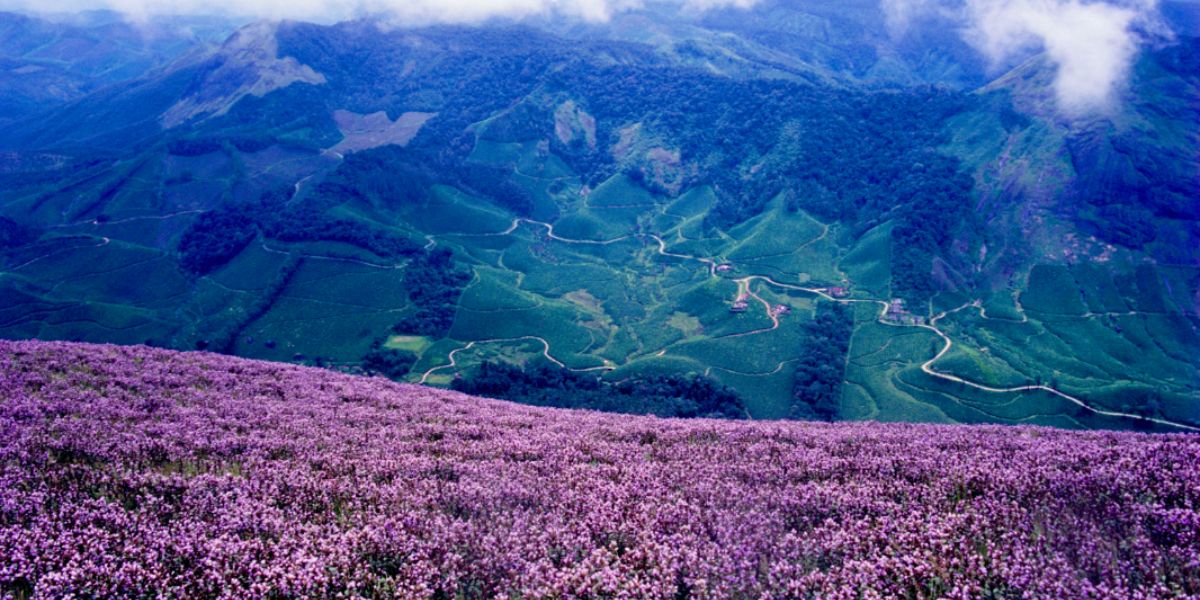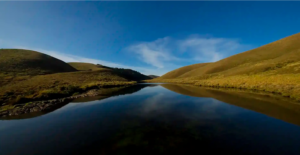Eravikulam National Park, along with its four neighbouring protected areas — Chinnar Wildlife Sanctuary, Anamudi Shola National Park, Kurinjimala Wildlife Sanctuary, and Pambadum Shola National Park — has become a must-visit destination for nature lovers.
Published Apr 03, 2025 | 12:00 PM ⚊ Updated Apr 03, 2025 | 3:18 PM

Neelakurinji (Strobilanthes kunthiana) blooms in the areas around the Eravikulam National Park in 1994. (Balan Madhavan/Kerala Tourism)
Synopsis: Eravikulam in the Idukki district of Kerala was designated a national park on 19 May 1978. Its journey from a game reserve to a sanctuary for the endangered Nilgiri tahr is a fascinating tale of colonial ambition, exploration, and unexpected conservation.
Only a few places can claim a history as dramatic as the Eravikulam National Park in the Idukki district of Kerala.
The transformation of this vast wilderness in Idukki, half a century ago, is a tale filled with unexpected twists, high-stakes negotiations, and an unlikely deal that sealed the fate of one of Kerala’s most treasured ecosystems.
Imagine a landscape once earmarked for tea plantations, then turned into a private game reserve, later considered for distribution among the landless — only to ultimately become a sanctuary for rare and endangered species.
Picture a national park whose journey was shaped by the direct intervention of a prime minister, a chief minister caught in the debate, determined conservationists lobbying for its protection, and an IAS officer navigating delicate negotiations.
At the heart of this incredible story lies Eravikulam National Park, whose path to becoming Kerala’s first national park began 50 years ago.
On 31 March 1975, the Kerala government took the first bold step, declaring the region the Eravikulam-Rajamala Wildlife Sanctuary. However, the fight for its preservation was far from over.
Just three years later, on 19 May 1978, Eravikulam was officially elevated to the status of a National Park — a landmark victory for conservation. This decision safeguarded not only the breathtaking Nilgiri tahr, which roams its rugged cliffs but also the mystical Neelakurinji flower, which cloaks the hills in purple once every twelve years, along with countless other rare species thriving in the Western Ghats, a UNESCO-recognised biodiversity hotspot.
The national park is open for visitors from 1 April, after the end of the calving season for the animals.
Eravikulam — also known as Hamilton’s Plateau — was once a private game reserve owned by the Kanan Devan Hills Produce Company (KDHP).
However, its journey from a game reserve to a sanctuary for the endangered Nilgiri tahr is a fascinating tale of colonial ambition, exploration, and unexpected conservation.
Back in 1854, one of the first recorded visitors, D Hamilton, was mesmerised by the landscape. He wrote: “The High Range, with its deeply dissected valleys, massive peaks, and towering crags, is surpassingly grand and incomparably beautiful.”

Eravikulam National Park. (Kerala Tourism)
By 1877, John Daniel Munro, a British officer in the Kingdom of Travancore, secured the first land concession from the Poonjar Raja for the sprawling Kannandevan Anchanatu Mala or Anjanad.
That same year, British officers Henry Gribble Turner and AW Turner, guided by the indigenous Mudhuvan people, scaled the mighty Anamudi Peak.
However, beyond the sheer beauty, they saw something more — a land brimming with commercial potential. What followed was a wave of plantations, as smallholders purchased land, attempting to cultivate cinchona, coffee, sisal, and tea.
By 1879, these pioneers had organised themselves into the North Travancore Land Planting and Agricultural Society Limited.
However, the Eravikulam plateau proved unsuitable for tea cultivation.
Instead of abandoning it, the company preserved this spectacular landscape, inadvertently protecting the world’s largest population of the Nilgiri tahr.
Recognising its ecological significance, the company designated Eravikulam as a private game reserve around Anamudi. By 1936, the Rajamalai region — including the peak — was officially declared a sanctuary, with hunting strictly controlled.
In 1970, JC Daniel of the Bombay Natural History Society lauded the company’s conservation efforts, noting that despite paying an annual tax of ₹40,000, they chose to preserve the land rather than exploit it.
The High Range Game Preservation Association (HRGPA) took on the responsibility of policing the sanctuary, appointing game watchers, and restricting hunting.
Intriguingly, MK Ranjitsingh, an IAS officer and conservationist revealed in his book ‘A Life with Wildlife – From Princely India to the Present’, that controlled hunting was initially allowed.
“The Nilgiri tahr was not placed in Schedule I of the Wildlife Protection Act, as its largest population thrived under the Kanan Devan Hills Plantations Company’s watch,” he noted.
The company permitted the selective hunting of only one or two mature ‘saddleback’ males annually — a controversial practice that, ironically, helped sustain over 600 tahrs on the leased land.
He further noted, “Though the KDHP had been paying an annual land tax on the whole estate, Eravikulam-Rajamala had never been planted nor cultivated, even by the original inhabitants, the Muduvan tribe. The only use had been fishing and selective hunting by the tea garden managers. The Muduvans were employed as game guards.”
In 1971, the Kerala government, led by the Communist Party of India (CPI), revoked the lease granted to KDHP by the Raja, citing the company’s failure to use the Eravikulam-Rajamala area for tea cultivation according to the original agreement.
The CPI government headed by C Achutha Menon had pledged to redistribute the unoccupied land to the landless. The following year, the Supreme Court upheld the government’s decision, setting off an unforeseen crisis.
With the KDHP losing control of the region, poachers moved in, and the HRGPA halted its practice of providing salt licks for the endangered Nilgiri tahr (as there is natural deficiency of salt in the soil and vegetation, salt lick is a major attraction) — an act that had previously drawn the animals together, making them easy targets.
Sensing the urgency, Ranjitsingh, responding to an SOS from HRGPA members JC Gouldsbury, KN Chengappa, and Samar Singh, travelled to Munnar with then Kerala’s Chief Wildlife Warden KK Nair.
Determined to save the fragile ecosystem, Ranjitsingh took his plea to the then-Kerala Food and Forest Minister Baby John in Thiruvananthapuram.
He warned that Eravikulam-Rajamala, with over 600 cm of annual rainfall and winter temperatures dropping below freezing, had never been inhabited — even by the indigenous Muduvans.
Any attempt at cultivation, he argued, would strip away the thin, nutrient-poor topsoil, leaving behind a barren rock. His message was clear: Eravikulam must become a national park.
Yet, the deadlock was undeniable.
According to Ranjitsingh, though Baby John was most courteous and patient he made it clear that his party and the ruling government had promised a windfall for the landless.
The minister pointed out to Ranjitsingh, as he mentioned in the book that, “If the state government declared it a national park, the KDHP could revert to the courts and claim that while the lease had been revoked on the argument that the area was not used for agriculture as stipulated, now the government was itself declaring it a place for wildlife rather than cultivation.”
However, will KDHP indeed do that? Ranjitsingh wrote in the book that he reached out to Gouldsbury and his team and they were determined to preserve what they had safeguarded for over a century as part of India’s natural heritage.
“To prove their commitment, they pledged to keep funding the Muduvan guards to protect the land — despite losing legal ownership — and even offered the Kerala government a written assurance: If Eravikulam-Rajamala was declared a wildlife sanctuary or national park, they wouldn’t challenge it in court.”
Ranjitsingh had pursued the matter tirelessly, even escalating it to the highest levels of power. He had taken up the case with the Prime Minister’s Office, prompting none other than Indira Gandhi herself to personally write to Kerala Chief Minister Achutha Menon, urging him to declare the area a national park.
Despite this high-profile intervention, the proposal languished in bureaucratic limbo — stalled by the state government’s reluctance, wary of potential political repercussions.
Then, fate intervened.
At the time, Annasaheb Shinde was the Minister of State for Food, while Sher Singh held the Forest portfolio. But with Singh away on tour, Shinde was temporarily overseeing forests and wildlife — a rare and unexpected turn of events.
Ranjitsingh, then serving under the Minister of Food and Agriculture, had gone to meet Shinde for an entirely unrelated matter. As their discussion wrapped up and he prepared to leave, Shinde casually asked him a question — one that would change everything.
“Do we have any pending issues with Kerala’s forest department?” Shinde inquired. “Their minister, Baby John, is coming to see me.”
Seizing the moment, Ranjitsingh launched into the entire saga of Eravikulam — the unheeded appeals, the prime minister’s direct request, and the state’s stubborn hesitation. Shinde listened intently, then made a decisive call.
“Join me in the meeting with John,” he said. It was the opening Ranjitsingh had been waiting for.
In a year of poor harvest, Kerala found itself in dire need of rice — its staple food.
Baby John set out on a mission to Delhi, hoping to convince the Union government to release forty railway wagons of rice from the Food Corporation of India. What followed was an extraordinary negotiation — one that now feels almost mythical.
As Rajitsingh later recalled in his book, the discussion was fascinating, free of acrimony, and full of political wit.
Baby John laid out Kerala’s predicament, emphasising the urgent need for rice. Union Minister Shinde immediately offered twenty-five wagons.
But then, with a glint in his eye, he posed a counter-question: “And what about the national park?” Baby John exchanged a knowing glance with me, smiled, and replied with the classic bureaucratic phrase: “The state is actively considering it.”
And so, the negotiations unfolded — tahr in exchange for rice.
By the end of this unusual barter, the deal was sealed: Thirty-six wagons of rice in return for the declaration of Eravikulam National Park and Rajamala Sanctuary — part of the rice to be dispatched immediately, the rest after the official announcement of the protected areas.
Looking back, Ranjithsingh himself reflected, “Today, this barter sounds like a fairy tale. But it did happen.”
Eravikulam National Park, along with its four neighbouring protected areas — Chinnar Wildlife Sanctuary, Anamudi Shola National Park, Kurinjimala Wildlife Sanctuary, and Pambadum Shola National Park — has become a must-visit destination for nature lovers.
Nestled in the breathtaking landscapes of Devikulam Taluk in Idukki, under the Munnar Wildlife Division, this region is best known for its star attraction: the Nilgiri tahr, the endangered mountain goat that roams its rugged cliffs.
Despite the Nilgiri tahr being the park’s iconic species, efforts to honour it with a dedicated day have not borne fruit in Kerala. In 2020, journalist and author MJ Babu submitted a memorandum to the state government, urging it to declare 31 March as Nilgiri Tahr Day. Unfortunately, his plea went unheard.
Meanwhile, Tamil Nadu took a step forward in 2023, officially designating 7 October as Nilgiri Tahr Day. The date was chosen to honour ERC Davidar, a pioneering wildlife conservationist whose groundbreaking studies brought global attention to the species.
(Edited by Muhammed Fazil.)
